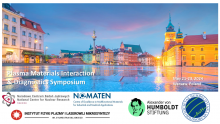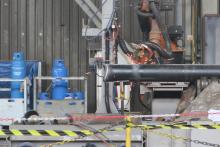NOMATEN - archive
This archive also has a search function.
NOMATEN hosts a Symposium on Plasma Materials Interactions and Diagnostics from May 21-23, 2024. This hybrid event offers in-person and virtual participation options, aiming to bridge scientific collaborations between Poland and the EU. We are honored to feature Dr. Marcin Jakubowski from the Max Planck Institute for Plasma Physics, Dr. Andrea Sand from Aalto University, Dr. Christophe Ortiz from CIEMAT, Dr. Miroslaw Zlobinski from Forschungszentrum Jülich, and Dr. Roman Zagórski from National Centre for Nuclear Research as a distinguished speakers.
Polymer derived ceramics, PDCs, are a group of silicon-based ceramic materials that are gaining increasing interest. The most common ones are carbide, oxycarbide, oxynitride, or silicon nitride. They are characterized by high thermomechanical stability, oxidation and chemical resistance, as well as bioactive and catalytic properties. These materials are obtained based on the pyrolysis of preceramic precursors, most often organosilicon polymers. Thanks to this approach...
Structural nuclear materials are subjected to neutron irradiation at elevated temperature, thereby affecting the operational lifetime of various critical reactor components. Dose-dependent material damage directly depends on dislocation-mediated plasticity mechanisms and their interactions with the irradiation defect microstructures, in the form of interstitial and vacancy clusters. Corresponding plastic strain spreading mechanisms...
As we head towards 2030 and 55% carbon emission reduction targets with the ultimate goal of net zero carbon by 2050. It has become evident that materials and the source of such materials will play a key role for future generations of devices and products. This along with the depletion of petroleum resources and their associated environmental...
Oxide dispersion-strengthened materials are reinforced by a (Y, Ti, O) nano-oxide dispersion and thus can be considered as nanostructured materials. Designed to serve in extreme environment – i.e., a nuclear power plant – the challenge for ODS steels is to preserve the nano-oxide dispersion under irradiation in order to maintain the excellent creep properties of the alloy in the reactor. Under irradiation...
The talk describes the investigations on high-Ni, high-Mn and low-Cu weld metals from the decommissioned Barsebäck 2 boiling water reactor (BWR) reactor pressure vessel (RPV). The reactor pressure vessel head (RPVH) weld and axial and circumferential beltline welds of the Barsebäck 2 RPV have been studied. The investigations includ...
The CoE NOMATEN team (NCBJ + VTT) on March 13-15, 2024 visited companies in the Gdańsk Pomerania region that implement numerous energy projects, including nuclear energy, solutions in the field of renewable energy sources and a sustainable energy system in the country and in Europe. Another on-site visit of CoE NOMATEN directly to production plants was aimed at presenting the research and design capabilities of the NOMATEN Center and encouraging companies to implement joint research and implementation projects in the field of energy solutions and material technologies.
Microstructural stability of multi-component systems under extreme environment represents one of most challenging issues not only in multi-scale materials modelling but also for developing reliable and advanced engineering components for nuclear material applications. Recently, compositionally complex alloys (CCAs) are designed as novel radiation-resistant materials for future fusion power plants while...
NOMATEN Centre of Excellence located at the National Centre for Nuclear Research (NCBJ) invites you to save the date and make plans to join us for the International Radiopharmaceutical Conference NOMRad which will be held June 25 - 27, 2024 at the Novotel hotel located in the city center of Warsaw. NOMRad Conference is organized in the frame of project granted by the Polish National Agency for Academic Exchange (NAWA) under Welcome to Poland programme, as well as the NOMATEN Teaming Coordination and Support action.
The development of chemical reactions that can be performed in living systems (i.e. cells, model organisms) has long held unique fascination in the field of chemical biology. A bio-orthogonal reaction is characterized by the reaction of two functionalities, which will react under mild physiological conditions and are inert towards the biological environment.








